#chandrayaan-3 spacecraft
Text
See 1st photos of the moon's south pole by India's Chandrayaan-3 lunar lander
By Tereza Pultarova
23 August 2023
India's Chandrayan-3 mission has nailed its lunar landing.

The first images from India's Chandrayaan-3 mission taken after the probe's historic moon touchdown reveal a pockmarked surface near the lunar south pole.
The Indian Space Research Organisation (ISRO) shared the images on X, formerly Twitter, on Wednesday (August 23), about four hours after the Chandrayaan-3 spacecraft completed its smooth descent.
The first set of four images were taken by the lander's Horizontal Velocity Camera as it was nearing the surface of the moon.
An additional image from the Landing Imager Camera, shared a little later, shows a glimpse of the landing site, including a portion of the spacecraft's landing leg and its shadow.
"The communication link is established between the Ch-3 Lander and MOX-ISTRAC, Bengaluru," ISRO said in a post on X.
"Chandrayaan-3 chose a relatively flat region on the lunar surface," the agency added in the subsequent post.
The landing made India only the fourth country in history to successfully put a spacecraft on the surface of the moon, after the United States, the former Soviet Union and China.
Chandrayaan-3 is also the first spacecraft in history to touch down near the lunar south pole, an area that is currently attracting the attention of scientists and space agencies from all over the world.
Scientists think that the permanently shadowed polar craters contain water ice trapped in the rocks, which could be extracted and used to support a permanent human presence on Earth's natural companion.
Moreover, these lunar craters could be used to build next-generation telescopes that would allow astronomers to see farther than they can today.
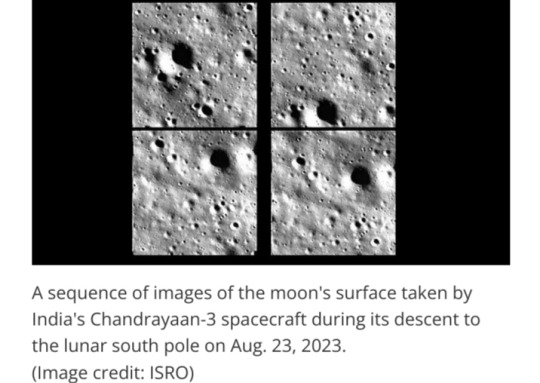
A small rover called Pragyan arrived on board Chandrayaan-3 and will soon deploy and commence its exploration of the exciting region, so many more fascinating images are likely to come soon.
Both the rover and the lander, however, are unlikely to remain operational for more than two weeks, as ISRO doesn't expect the vehicles' batteries to make it through the two-week lunar night.
Chandrayaan-3 was India's second try at landing near the moon's south pole.
The country's first attempt at a lunar touchdown, in September 2019, failed when the Chandrayaan-2 lander crashed into the moon due to a software glitch.
India's triumph comes only three days after Russia lost its Luna-25 mission, its first attempt to put a spacecraft on the moon's surface in 47 years.
Luna-25, too, was aiming for the lunar south pole but crashed into the moon instead after a botched orbital maneuver on Saturday (August 19).
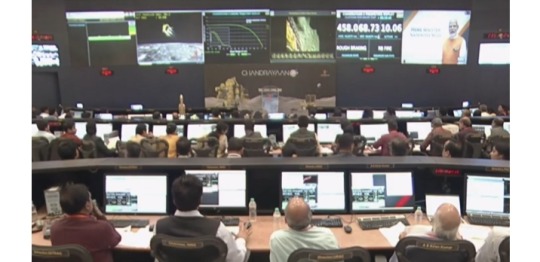


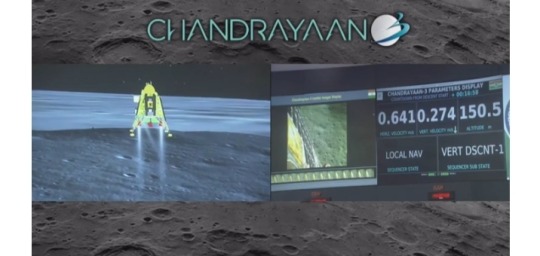

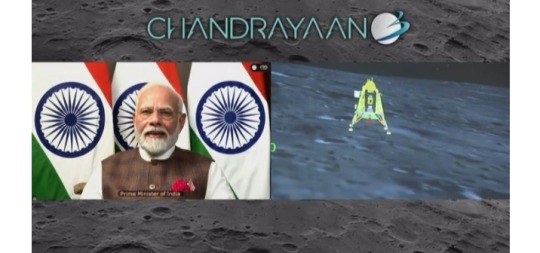

#Chandrayaan-3#Chandrayaan-3 lunar lander#Indian Space Research Organisation (ISRO)#Chandrayaan-3 spacecraft#Horizontal Velocity Camera#Landing Imager Camera#next-generation telescopes#Pragyan#India#moon#lunar landing#spacecraft#moon landing
2 notes
·
View notes
Text
The amazing camera aboard ISRO's Chandrayaan-3 that took this amazing moon photo
The Chandrayaan-3 mission, ISRO’s remarkable unmanned lunar endeavour, has gifted us with mesmerising visuals of both the Moon and Earth, enhancing our understanding of these celestial bodies.
Intricate Details Revealed
This awe-inspiring photograph, showcasing intricate lunar craters in great detail, was masterfully taken upon the spacecraft’s entrance into the Moon’s orbit on August 5th. This…

View On WordPress
#celestial photography#Chandrayaan-3#Chandrayaan-3 camera#Chandrayaan-3 instruments#Chandrayaan-3 isro#Chandrayaan-3 moon#chandrayaan-3 spacecraft#India moon mission#Indian Space Research Organization#ISRO#ISRO moon#lunar mission#moon Chandrayaan-3#unmanned lunar mission
0 notes
Text

This is the image of the Indian Chandrayaan 3 lander. Chandrayaan 3 is a follow-up moon exploration mission of Chandrayaan 2. The Chandrayaan 3 was launched on 14th July 2023 and it is expected to land on the moon on 23rd August 2023. A spacecraft or vehicle that is intended to touch down on the surface of a celestial body, such as a planet, moon, or asteroid, is known as a lander. An upgraded version of the Vikram lander from Chandrayaan 2 is present in Chandrayaan 3. It also has four landing thrusters and four landing legs and is box-shaped. The rover and many scientific tools will be aboard for performance in site analysis. If you want to know more about Chandrayaan 3 and its lander, Visit My Article.
5 notes
·
View notes
Text
Chandrayaan 4 is to be launched in 2 phases, both LVM-3 and PSLV to be used
Following its extraordinary achievement with the Chandrayaan-3 mission, the Indian Space Research Organisation (ISRO) is now preparing for its upcoming lunar mission, named Chandrayaan-4.
Unlike Chandrayaan 3, the mission will not be launched in a single phase; rather, it will involve two separate launches to deploy vehicles that will not only land on the Moon but also collect and return rocks and soil (lunar regolith) from the lunar surface to India.
While Chandrayaan-3 is comprised of three primary components – a lander, rover, and propulsion module, the Chandrayaan-4 mission will incorporate two additional components dedicated to retrieving samples from the Moon and delivering them back to Earth.
What are the components of Chandrayaan 4?

As per a presentation by Isro chief S Somnath at the National Space Science Symposium, the Chandrayaan-4 will comprise five spacecraft modules.
To Read More Click here...
#science#science news#science blogs#science updates#chandrayaan 4#ISRO#PSLV#LVM-3#new updates#spacecraft
0 notes
Text
Embark on a thrilling cosmic journey with us as we explore the Supra Thermal & Energetic Particle Spectrometer (STEPS), a crucial component of Aditya-L1's ASPEX payload, and discover the secrets of space particles from the Sun before it reaches its final destination at the L1 point!
#SpaceExploration #SolarProbe #STEPS #ASPEXMission #AdityaL1 #SpaceWeather #Sun #CosmicJourney #L1Point #SpaceExploration #SolarParticles #STEPS #BeforeDestination #ASPEX #SpaceWeather #Sun #SpaceScience #CosmicMysteries
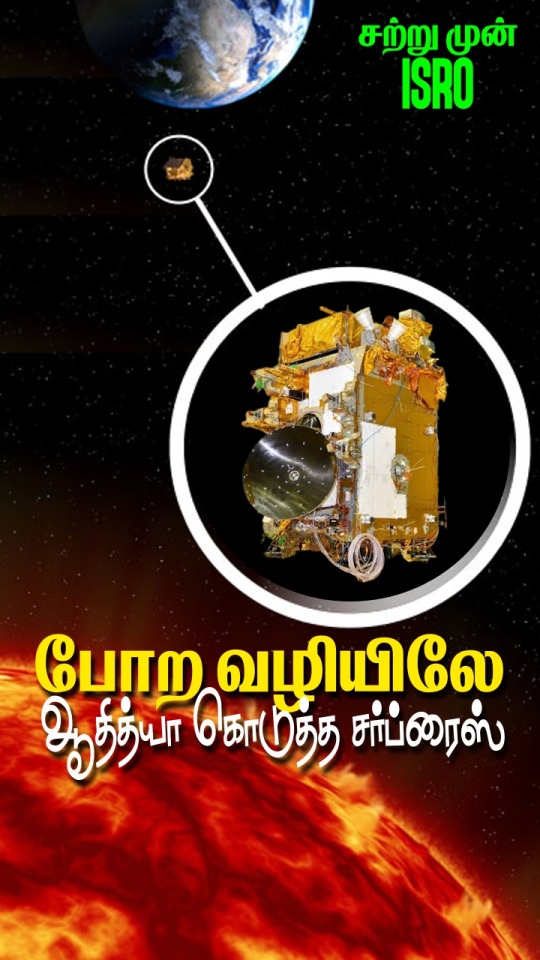
#Supra Thermal & Energetic Particle Spectrometer#Aditya-L1 Solar Probe#ASPEX payload#Earth's magnetic field#spacecraft mission#space research#scientific exploration#cosmic mysteries#MR. GK#electrons in space#L1 point#pre-destination insights.#Chandrayaan-3#ISRO#Lunar Exploration#Pragyaan Rover#Space Discovery#Moon Mission#Lunar Surface#Space Exploration#Lunar Secrets#Space Agency#Lunar Exploration Update.#rover#isro#MADAN GOWRI#TAMIL POKKISHAM
0 notes
Text
When to watch the live telecast?
The live telecast of the landing will begin at 5:20 pm (IST) on Wednesday. Live actions of landing will be available on the ISRO website, its YouTube channel, Facebook, and public broadcaster DD National TV from 5:27 pm (IST) on August 23.
Where to watch the live telecast?
The live telecast can be viewed on the Doordarshan TV channel, the ISRO website as well as social media platforms.
0 notes
Text

India successfully lands on the moon
Chandrayaan-3 makes India the fourth nation to successfully land a spacecraft on the moon, joining the Soviet Union, the United States and China.
10K notes
·
View notes
Text
I want yall to realise how momentous this is and how much we could do. Chandrayaan 3 had a budget of Rs 615 crore, that's roughly $74 million. For less than a two hundredth of elon musk's net worth, a country with a per capita income of $2000 sent a spacecraft to the Moon's south pole.
#like IMAGINE what rich people could do with their money#think of what we could learn with money that literally just assists in one man's vanity#we WENT TO THE MOON#chandrayaan3#Chandrayaan 3#isro#desiblr
192 notes
·
View notes
Text
By John Parker
This award-winning Apple TV+ series depicts an “alternate history” set in the 1970s that is intent on showing that U.S. imperialism is the only way forward. The TV series also uses diversity, which should be a good thing, but it is unfortunately used to hide U.S. imperialism’s war crimes, like Vietnam.
The “alternate history” portrays the U.S. as an underdog victim of the Soviet Union
#apple tv#imperialism#propaganda#space exploration#cold war#Pentagon#Vietnam War#ussr#for all mankind#russia#ukraine#proxy war#john parker#struggle la lucha
72 notes
·
View notes
Text
Fresh off its first-ever successful robotic moon landing, India aims to put an astronaut on the lunar surface by 2040 and build an Earth-orbiting space station by 2035, the nation's government said on Tuesday (Oct. 17).
On Aug. 23, India became just the fourth nation ever to soft-land a spacecraft — its Chandrayaan-3 lander-rover duo — on the surface of the moon. In a recent meeting with the Indian government department that manages the country's space program, Prime Minister Narendra Modi "directed that India should now aim for new and ambitious goals," according to an official statement.
India's future moon exploration efforts will include a series of additional robotic Chandrayaan missions, a new launch pad and a heavy-lift launch vehicle, the statement added.
Continue Reading.
75 notes
·
View notes
Text
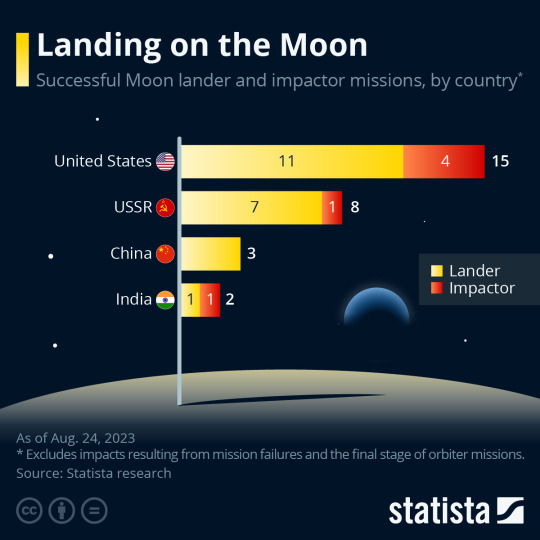
After India's Chandrayaan-3 touched down on the moon on Wednesday, India became just the fourth country to have successfully landed a spacecraft on the lunar surface. Chandrayaan-3 is also the first lander to arrive intact on the south pole of the moon. This now marks the second moon-based success for India's space agency the ISRO. After orbiting the Moon for 312 days, Chandrayaan-1 deployed a moon impact probe in November 2008, releasing underground debris that, after analysis by the orbiter, confirmed the presence of water.
Full article >>
67 notes
·
View notes
Text

CNN — Japan’s “Moon Sniper” robotic explorer landed on the lunar surface, but the mission may end prematurely since the spacecraft’s solar cell is not generating electricity, the Japan Aerospace Exploration Agency said.
The agency said it is currently receiving a signal from the lander, which is communicating as expected.
The uncrewed Smart Lander for Investigating Moon, or SLIM, mission landed just after 10:20 a.m. ET Friday (12:20 a.m. Saturday Japan Standard Time), according to telemetry data shared on JAXA’s live broadcast.
Currently, the lander is operating on limited battery power, only expected to last several hours.
The JAXA team is analyzing the data to determine the cause of the solar cell issue and the next steps for the lander.
It’s possible that the solar cell issue is due to the fact that the spacecraft is not pointing in the intended direction, JAXA officials said.
There is hope that as the solar angle changes on the moon, the solar cell may be able to charge again, but that may take some time and will depend on whether SLIM can survive the frigid lunar night, the team shared during a news conference.
The agency believes the mission has met the criteria to declare it a “minimum success,” because the spacecraft achieved a precise and soft lunar landing using optical navigation.
The touchdown makes Japan the third country this century — and the fifth ever — to land on the moon.
When asked to score the landing operation for SLIM, JAXA director general Dr. Hitoshi Kuninaka gave it a “60 out of 100,” while also mentioning that he is known for making “harsh comments.”
The team is also working to gather all of the scientific data obtained by the lander.

The lander was able to release its two lunar rovers, LEV-1 and LEV-2.
The LEV-1 rover moves using a hopping mechanism and is equipped with wide-angle visible light cameras, scientific equipment, and antennas that allow it to communicate with Earth.
And LEV-2, also outfitted with cameras, can change shape to move across the lunar surface.
The team is receiving a signal from LEV-1 and will see whether its cameras were able to capture any images.
JAXA officials said they will not definitively confirm the status of LEV-2 until more data is received.
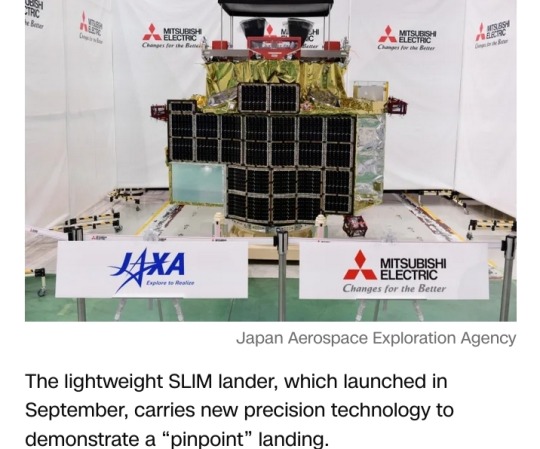
The small-scale SLIM robotic explorer, which launched in September, goes by the nickname “Moon Sniper” because it carried new precision technology to demonstrate a “pinpoint” landing.
Previous lunar missions have been able to target and reach specific zones that spanned many kilometers, but the SLIM lander targeted a landing site that stretches just 100 meters (328 feet) across.
The lander’s “smart eyes” — an image-matching-based navigation technology — rapidly photographed the sloped lunar surface on approach and autonomously made adjustments as the spacecraft descended toward touchdown.
The JAXA team is still working to determine the accuracy of SLIM’s landing, which could take up to a month.
Moon Sniper’s journey
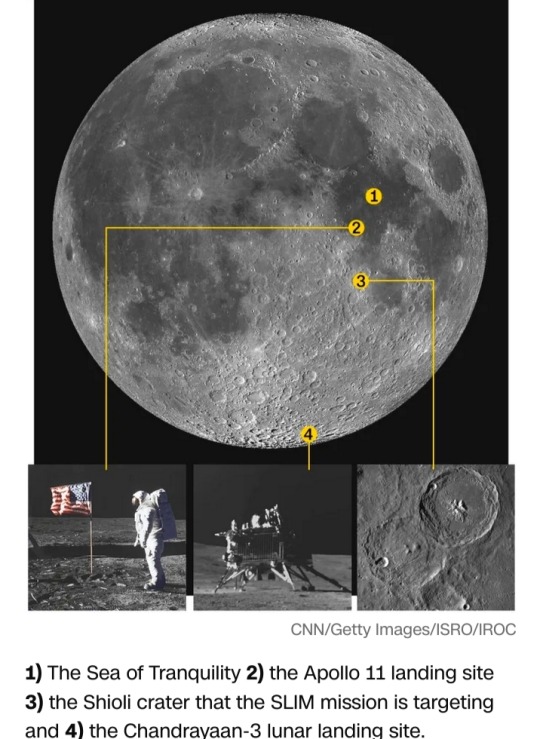
The Moon Sniper targeted a landing site near the small Shioli crater within a lunar plain called the Sea of Nectar that was created by ancient volcanic activity and lies just south of the Sea of Tranquility, where Apollo 11 landed in 1969.
The lander is designed to briefly study rocks at the site that could reveal insights into the moon’s origin.
When meteorites and other objects strike the moon, they create craters as well as rocky debris that litters the surface.
These rocks intrigue scientists because studying them is effectively like peering inside the moon itself.
Minerals and other aspects of the rocks’ composition can potentially shed more light on how the moon formed.
Landing near the sloped, rock-strewn areas around craters is a hazardous process that most missions usually avoid, but JAXA believes its lander has the technology to touch down safely on rocky terrain.
New space race

Multiple space agencies and countries have attempted moon landing missions over the past year, leading to a historic first as well as failures.
India became the fourth country — after the United States, the former Soviet Union and China — to execute a controlled landing on the moon when its Chandrayaan-3 mission arrived near the lunar south pole in August.
Meanwhile, Japanese company Ispace’s Hakuto-R lunar lander fell 3 miles (4.8 kilometers) before crashing into the moon during a landing attempt in April.
Russia’s Luna-25 also crash-landed in August during the country’s first attempt to return to the moon since the Soviet Union’s fall.
Astrobotic Technology’s Peregrine spacecraft — the first US lunar lander to launch in five decades — met a fiery end Thursday after a critical fuel leak made safely landing on the moon out of the question.
Part of the motivation behind the new lunar space race is a desire to access water trapped as ice in permanently shadowed regions at the lunar south pole.
It could be used for drinking water or fuel as humanity pushes the bounds of space exploration in the future.
This region is riddled with craters and strewn with rocks, leading to narrow landing sites.
The lightweight SLIM lander might be an effective design that could not only land in small areas of interest on the moon but also on planets such as Mars, according to JAXA.

#Moon Sniper#robotic explorer#moon#Japan Aerospace Exploration Agency#Japan#Smart Lander for Investigating Moon#SLIM#Dr. Hitoshi Kuninaka#LEV-1#LEV-2#lunar rovers#Sea of Nectar#Sea of Tranquility#Chandrayaan-3#Hakuto-R#Luna-25#Peregrine spacecraft#JAXA#space#space agencies
0 notes
Text
India has launched its third Moon mission, aiming to be the first to land near its little-explored south pole.
The Chandrayaan-3 spacecraft with an orbiter, lander and a rover lifted off at 14:35 on Friday (09:05 GMT) from Sriharikota space centre.
The lander is due to reach the Moon on 23-24 August.
If successful, India will be only the fourth country to achieve a soft landing on the Moon, after the US, the former Soviet Union and China.
!!!
#this is so cool!#it apparently launched at 9:05 GMT so like I missed the launch but that’s so fuckin awesome#space#astronomy#moon#india#rocket launch#isro#isromissions#isroindia#chandrayaan3
44 notes
·
View notes
Text
Chandrayaan-3's Historic Landing on moon redefines India's Space Prowess

Prepare to be awestruck as India's space giant, ISRO, achieves an extraordinary milestone with the triumphant landing of Chandrayaan-3 on the lunar surface! 🛰️🌙
📰 Dive into our latest article that narrates the epic journey of Chandrayaan-3, ISRO's third and most ambitious lunar exploration mission. From a flawless launch to a meticulously planned lunar landing, this mission redefines the boundaries of space exploration.
🌠 Discover the innovative spacecraft design, explore the rover's cutting-edge payloads, and delve into the scientific objectives that drove this historic achievement. Join us as we unpack ISRO's determination, innovation, and incredible success in unraveling the mysteries of the Moon.
📅 Don't miss out on this remarkable story that resonates with the spirit of exploration and human ingenuity. Read the full article now:
🔬🪐 Let's celebrate India's stellar contribution to space exploration together! Spread the word and dive into the cosmos with us. 🌌👩🚀 #ISRO #Chandrayaan3 #SpaceExploration #LunarLanding #InnovationBeyondBorders #historic
31 notes
·
View notes